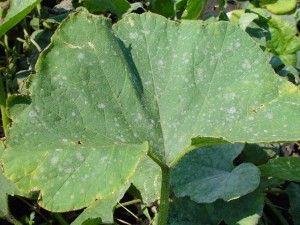Powdery mildew has been found on squash and cucumber in several Ohio counties statewide – about the time we expect it to appear in Ohio . Unlike downy mildew, powdery mildew can be managed pretty well after the disease appears, and preventative fungicide applications are not usually necessary. It is, however, very important to start scouting for the disease and begin fungicide applications as soon as the disease appears. Make sure to scout both sides of leaves – the white, circular colonies of the fungus that causes the disease can be on the upper surface, the lower surface, or both. Varieties that are resistant to powdery mildew usually need fewer, if any, fungicide applications. There are a number of fungicides that can be used for powdery mildew management, including sulfurs (e.g. Microthiol), chlorothalanil (e.g. Bravo), triflumizole (Procure), penthiopyrad (Fontelis), myclobutanil (Rally), and cyflufenamid (Torino). Quintec (quinoxyfen) is a very effective powdery mildew fungicide but is not labeled for edible peel cucurbits like cucumber, zucchini and yellow squash due to potential phytotoxicity issues. Tank-mixing products such as Quintec, Rally or Procure with a sulfur fungicide will provide broad-spectrum protection, although it should be noted that sulfur can be phytotoxic when applied under hot (>90 F) conditions. Insensitivity of the powdery mildew fungus to strobilurin fungicides such as Quadris and Pristine have been reported, so if one of these fungicides is included in the program, particularly to manage other diseases, it must be alternated with a fungicide with a different mode of action and tank mixed with a contact fungicide such as sulfur.
There are restrictions on the use of these fungicides on cucumbers or other cucurbit crops produced in greenhouses or high tunnels. Chlorothalanil and any of the strobilurin fungicides are not allowed in protected culture. See the Midwest Vegetable Production Guide for Commercial Growers 2014, p. 41, for more information. A number of biorational/biocontrol products are labeled for use in greenhouses and high tunnels, and may be effective against powdery mildew if combined with cultural practices such as promoting air flow and removing diseased tissue. Varieties with resistance to powdery mildew should be chosen whenever possible for production in greenhouses or high tunnels.


